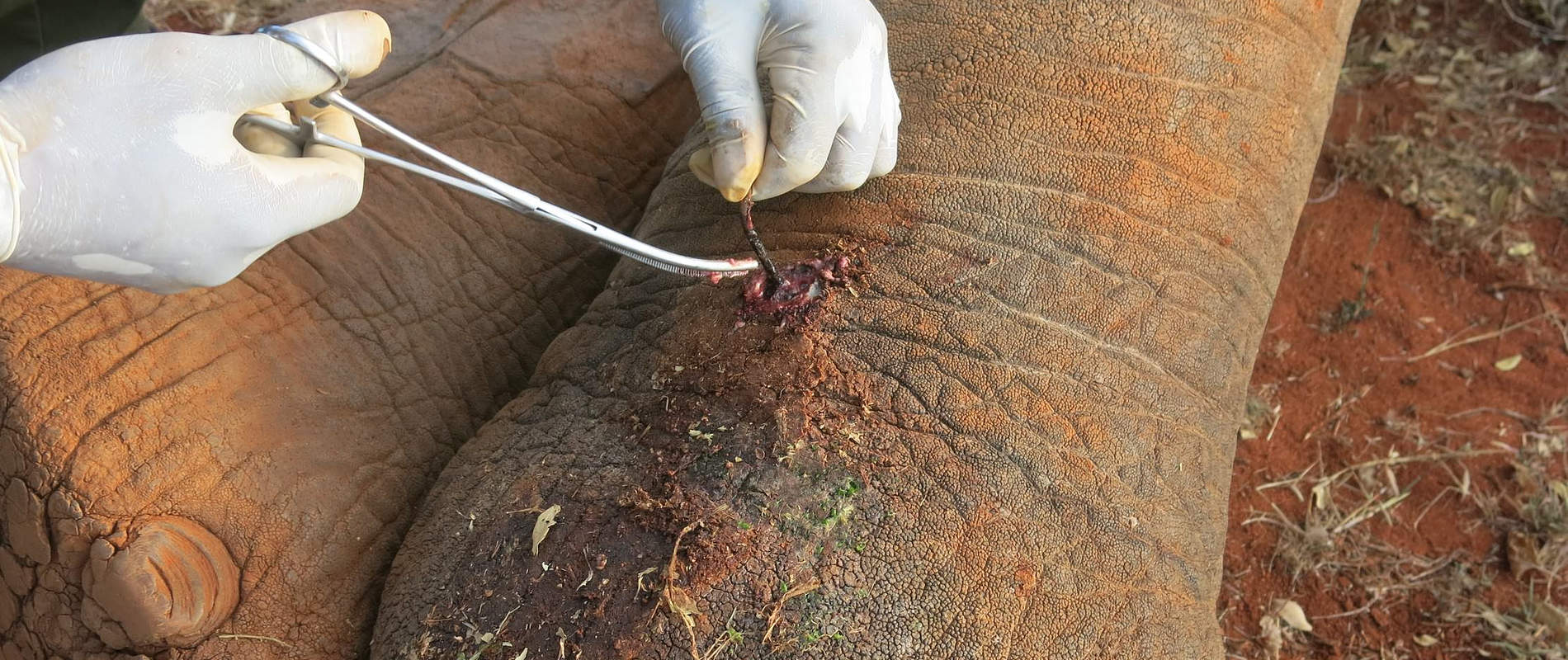Introduction The month under review was characterized by dusty, windy and cold cloudy days, substituted with still, cold dark nights
Introduction
The month under review was characterized by dusty, windy and cold cloudy days, substituted with still, cold dark nights. The surrounding community conservancies have hardly any vegetation to support domestic animals and wildlife. This has caused an influx of wild animals into Amboseli National Park swamps where they can browse, quench their thirst and wallow.
During the month, several cases were attended toincluding elephant spear injuries with the worst case being euthanized. A condition of retained afterbirth was encountered on one female elephant while the rest of the cases involved domestic cats and baboons within the Park.
- ELEPHANT TREATMENT REVIEW
Date: 1/07/2017
Species: Elephant
Sex: Female
Age: Adult
Location: Amboseli National Park
History
This elephant was initially treated for a spear wound on 28/5/2017. She was given a guarded prognosis because of the poor body condition she was in. The wound yielded copious amount of pus. She was to be monitored for two weeks and review her case.
On 14/6/2017 she was spotted again resting with the wound discharging pus. She appeared to have improved and gained muscle mass. She was scheduled for a retreatment after ten days. She was not seen then only to resurface on 1/7/2017. What followed were efforts to affect a successful retreatment exercise as indicated below.
The elephant was again sighted and reported to the Vet Unit by Cynthia of Amboseli Elephant Trust on 1/7/2017. ATE noted that the elephant was browsing well. Her condition had shown tremendous improvement. Though still depicting pus discharge from the spear wound. Efforts to force her out of marshy/swampy terrain were not successful hence no intervention was viable. Concerted efforts were mounted by the Elephant Trust and Vet Unit geared to spotting her and possibility of offering a successful intervention.
UPDATE 1
She was again sighted and reported to Vet Unit by ATE on 12/7/2017 browsing at the edge of road near Amboseli Lodge. After waiting over an hour to get a good position to dart her, and trying to push her out of a swampy area, she went into the swamp. It was observed that she was in good condition browsing and walking energetically though a streak of pus was visible at the spear wound. She was left hoping that another feasible opportunity would present itself. ATE confirmed that her family members were within the Park and it was optimistic that she would join her family members once she was energetic enough.


UPDATE 2
History/Update on above case
The Vet Unit while on its' normal patrol within the park spotted the candidate on 14/7/2017 within a swampy area browsing and wading through the marsh. She could not get out so still no meaningful intervention was practical.
It was noted that her muscle cover had begun to be noticeable and thus she was given favorable prognosis. It appeared that she was comfortable within that niche with plenty of browse and water. Monitoring still continues.
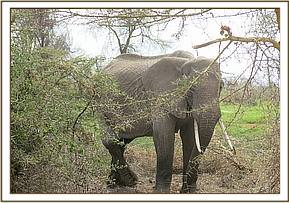

2. ELEPHANT TREATMENT
Date: 14/07/2017
Species: Elephant
Sex: Female
Location:Oltukai, Amboseli National Park
History
The elephant was observed depicting abnormal behavior lying down and getting up frequently. Upon close observation it was established to have raw red tissues emanating from its vulva opening. This was observed by KWS Corporal on patrol who immediately reported to residential Mobile Vet at Park Headquarters.
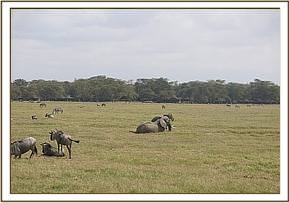

Pre-darting Observation
ATE research unit was informed of the elephant and they identified her positively as Galana and that the pregnancy was barely a year. This dawned that the female would be undergoing miscarriage. The raw red tissues now were hanging close to the ground impending smooth ambulation. The tissues appeared like fetal membranes and it was not easy to establish whether the fetus was out or not yet hence need to dart. She was forced out of the swamp edge to dry plain area where safe darting would be done by use of vehicle.
Immobilization and Examination
Darting was quickly doneusing 12mgs Etorphine and 1000 I.U Hyaluronidase. She was kept away from getting back to swampy area by use of vehicle. The raw red tissues were fetal membranes and had begun to necrotize thus foul smell could be picked. It was presumed that she had aborted about thirty-six hours ago and what was being observed was retained afterbirths.
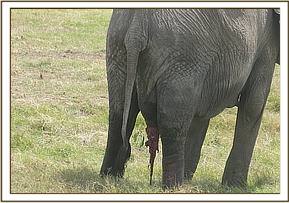

Treatment and Reversal
Twenty pessaries of 5gSulphadimidine were pushed into birth canal as far deep as the hand would reach. She was injected with 30000 mgs Amoxicillin into four different muscle sites equally followed with 100mgs Dexamethasone into ear vein. The distal perineal area was cleaned using plenty of water and later sprayed with one can of Tetracycline wound spray to repel the flies from mounting on previously discharge soaked areas. She was injected with 50mlCatosal as metabolic stimulant. Reversal was done and after two minutes she got up energetically. She explored the area and got the membranes on the ground. She picked them using trunk after smelling them and threw them away.
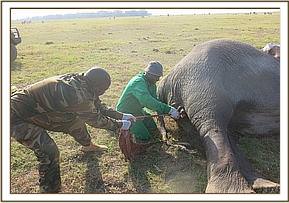
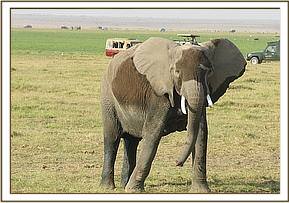

Prognosis
Good because traction was successful with no accompanying bleeding. She got up energetically thus she will lead healthy life but guarded procreativity since it was not easy to rule out infectious causes of abortion.
3. ELEPHANT TREATMENT
Date: 15/07/2017
Species: Elephant
Sex: Male
Age: Adult
Location: Amboseli National Park
History
The Mobile Vet Unit while on patrol within Amboseli Park came across a lone male elephant drinking when a creamy pussy discharge was observed at the right knee fold. It appeared to have been speared though ambulation was normal. Body score was at figure four taking figure five as the best muscle cover. An intervention to treat the injury ensued immediately.
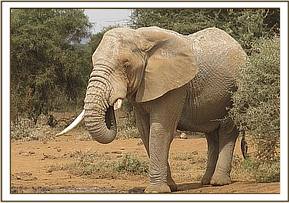
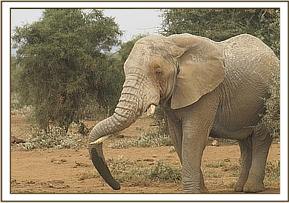
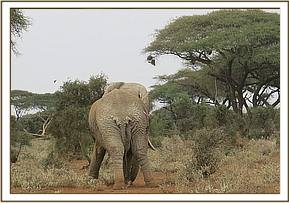

Examination andTreatment
It was darted on its way out of the drinking hole. The discharge was tenacious creamy pus from a sub-dermal pouch about twenty centimeters deep. It was probed using long forceps to determine its depth and find out if it had foreign body. No foreign body was recovered from it. The pouch was drained by fist pressing followed by thorough cleaning using Hydrogen Peroxide and rinsed with Tincture of Iodine. Wet green clay was packed into the pouch to the brim and Tetracycline wound spray was generously sprayed topically to repel flies.
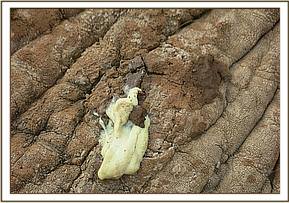
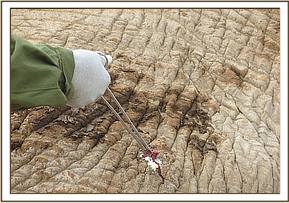
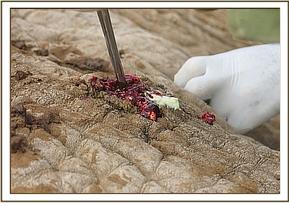

Reversal
It was reversed with 40mgs Naltrexone into superficial ear vein. It got up with one kick after three minutes post reversal administration. It walked away sluggishly.


Prognosis
Good because the injury was sub-dermal and was effectively drained and cleaned.
4. ELEPHANT RETREATMENT
Date: 19/07/2017
Species: Elephant
Sex: Female
Location: Amboseli National Park
History
It was during usual park patrol by the Amboseli Mobile Vet Unit that it came across the elusive elephant which was under surveillance since 28thMay 2017 when it was first treated of spear wound and indicated for a review since the injury had caused guarded prognosis.
She had been spotted severally thereafter as indicated above on 14/6/2017, 1/7/2017, 12/7/2017 and 14/7/2017 all of which posed risk of darting to effect retreatment because of the swampy terrain she was in. She had gained muscle cover substantially and a whitish spot at the spear wound was eminent indicating pus discharge from the wound.
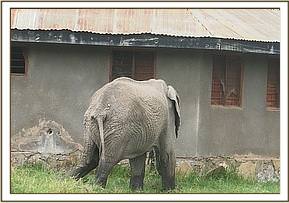

Immobilization
She was immobilized but the dart was poorly placed into what appeared to be right ischium joint resulting to standing immobilization after fifteen minutes. This could not allow any intervention and thus a second dart of the same amount of drug was placed on the right thigh resulting to dog sitting posture in five minutes. She was pushed to the right lateral recumbence manually.
Examination and Treatment
The spear wound was probed to examine the depth and open the wound to encourage maximal drainage and thorough cleaning. It was noted to have regressed remarkably only yielding about ten centiliters of creamy tenacious pus. It depth was estimated to be about fifteen centimeters rostrally from point of discharge and sub-dermally
The cavity was thoroughly lavaged using Hydrogen Peroxide and rinsed with Tincture of Iodine. Swaps were inserted severally in the process by use of forceps in order to get rid of any pus. It was infiltrated with 4500mgs of Amoxicillin followed by wet green clay packing to reduce dead space and encourage tissue regeneration. It was covered systemically with 30000mgs Tetracycline and 40ml Cyanocobalamin into different muscle sites. Dart wounds were infiltrated with 5gms of Cloxacilin antibiotic cream and another tube used to keep eyes moist and protected.
Prognosis
This was certainly revised to be good because the injury has regressed significantly and she was regaining weight thus getting out of danger. Though monitoring will continue she doesn’t need any further retreatment.
5. ELEPHANT TREATMENT
Date: 22/07/2017
Species: Elephant
Sex: Male
Location:Marba; Amboseli Ecosystem
History
The Amboseli Mobile Vet Unit was notified of a sick elephant in Marba by SW Amboseli National Park following a call from Big Life Foundation. It was reported to have a pus discharging wound located at mid abdomen on the right side. The vet Unit immediately responded to effect necessary intervention.
Observation andImmobilization
Foot approach was used first to ascertain the injury and health of the candidate to facilitate intervention planning. It was observed that the animal appeared to be wounded as reported, huge, emaciated at the level of two taking five to be the best and zero as the poorest. It was extremely old bearing huge tusks.
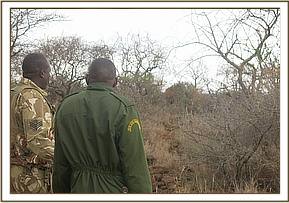

Darting was quickly achieved. Two vehicles were used to maintain him within sparsely thicketed terrain while the bull’s friend separated himself and walked off.
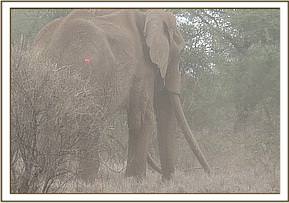

Examination and treatment
Examination on the right side revealed three wounds. Two penetrating wounds appeared to be as a result of spear; one being at the mid abdominal area about fifteen centimeters deep while the second one at right thigh posteriorly about thirty-five centimeters deep. The third one was on the mid right forelimb twenty centimeters in diameter with dry interior and pus-filled edges. It was discovered that this open wound had been treated as spear wound through sky vet initiative on 5/5/2017 at Satao. It was unfortunate that the elephant sustained three spear wounds between the 5/5/2017 and 22/7/2017 indicating that it had been identified as a poaching target because of its heavy tusks. The injuries had caused severe loss of condition hence the anticipated lassitude.Photos were taken and sent to Amboseli Elephant Trust to help in identification. It was confirmed that the candidate was not in their register. It was thought to have come from probably Tsavos, Chyulus or from neighboring country
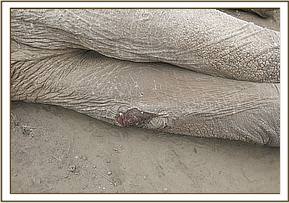

Reversal
Having anticipated the need for assistance in getting the elephant up after narcosis, a strap was put on the right tusk and anchored onto the vehicle to pull as the animal attempted lifting itself up. Despite several attempts to use two landcruisers to aid lifting the bull up, it appeared that it was too weak to get its head up. This was attributed to the fact that the animal was in very poor health and that the tusks were very heavy.
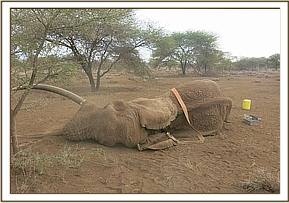

Prognosis
Considering the suffering of the elephant and the security threat posed by the huge tusks which were the reason why he had been speared mercilessly, he was put down humanely and the ivory secured. The weights of the tusks were 51kgs and 52 kgs.
6. ELEPHANT TREATMENT
Date: 23/07/2017
Species: Elephant
Sex: Male
Age: Adult
Location:Osewan; Amboseli Ecosystem
History
The elephant was reported on 22/7/2017 by Big Life Foundation Osewan Base as having bloody diarrhea for the last three days.
Pre-darting Observation
Big Life Personnel were met and led the way to where the animal was. It was spotted under the shade resting and as we attempted to dart it picked up our scent and charged at us aggressively sending us helter-skelter in thick bush.
After considering the initial copious bloody diarrhea reported and the current defecation it was resolved that the it was still strong after aggressiveness exhibited in the charge.
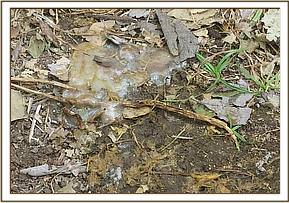
Conclusion
It was noted that the diarrhea cause was way beyond gastric gut because the blood and mucus in the dung appeared to be flank meaning they had not been digested. The exercise was curtailed and the candidate placed under monitoring for the next three to seven days after which if same bloody diarrhea is noted, an intervention would be fixed to treat it.
Discussion
There were several dimensions to the case. One being non-infectious causes like probable poisoning incidence because the candidate was thought to have raided crop fields bordering the community conservancy. Another could be from self-purgation (deworming) and associated stress but blood expression was of more concern. Also possibilities of bad or inappropriate food. Infectious causes could be intestinal infections such as colibacillosis, pseudomonas, clostridia and salmonellosis mostly in reared elephants not forgetting other forms of intestinal inflammations like colitis. Others are diseases of high alert such as anthrax.A keen surveillance was recommended both for the candidate movements and to establish the possible location of poisoning and mitigate accordingly through reach out programs and mount Problematic Animal Control Measures. Another could be
Prognosis
This was considered to be guarded considering the impending dangers of diarrhea especially dehydration and accompanying complications. Nevertheless, high alert is ongoing.
7. WILDEBEEST TREATMENT
Date: 25/07/2017
Species: Wildebeest
Sex: Male
Age: Calf
Location: Amboseli National Park
History
The calf had been treated on 30/6/2017 of abscess on right hind thigh. A review was scheduled to be done after two weeks but it was on the above date that it was sighted at the location as per GPS coordinates given.
Review Observation
It was found within a herd of more than twenty wildebeest. It was observed that it was able to keep up with the pace of the group. Its abscess was noted as little swelling with no discharge. In comparison with the age mates’ sizes it appeared to be small and also its gait was a little bit abnormal depicting little flexion of right femoral joint in walking gait.


Prognosis
This was revised from guarded to favorable and it seemed to be out of initially feared predation danger. Monitoring will continue and the unit will intervene if need be.
8. ELEPHANT REVIEW
Date: 28/07/2017
Species: Elephant
Sex: Male
Age: Adult
Location:Osewan; Amboseli Ecosystem
History
The elephant was first reported on 23/7/2017 (case # 8 above). It was again reported to Mobile Vet Unit by Amboseli National Park Community Warden as being recumbent on 28/7/2017. The Vet Unit set out to find out the cause of recumbence.
Observation
The elephant was found on right lateral recumbence with signs of struggle meaning it had been recumbent for some time. It was confirmed that it was the same candidate with diarrhea and obvious was the foul smell emanating from its rectal area.


Treatment /Intervention
The primary aim of intervention was to eliminate the cause of disease with the major part of treatment being supportive and symptomatic, aimed at relieving pain, correcting fluid abnormalities and allowing healing to occur.
Reversal
After a fewminutes, it tried to lift its head up and several attempts to assist it using vehicle to light up proved futile.
A decision was reached to put it down to avoid more suffering and secure the tusks from opportunistic poachers. This was done humanely and a postmortem was conducted immediately.
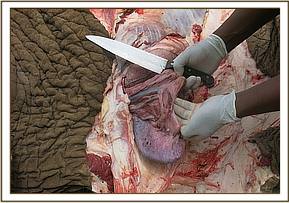
Postmortem
Important findings were;
-Animal was dehydrated as shown by sunken eyes and inelastic skin with pale mucus membranes
-There were hardly any pleural and peritoneal fluids internally.
-Lungs had adhered strongly to the pleural lining/rib cage internally and depicted prominent interstitial partitions.
-The whole gut contained little fluid of suspended plant matter and appeared paler. The glandular stomach downward was heavily infested with worms
-Omentum blood vessels were highly congested thus prominent and intestinal lymph nodes were enlarged.
-Spleen was enlarged as shown by absence of sharp edges, hard on consistency, its capsule thickened and with highly demarcations of red and white pulps. No blood was expressed on cut squeezed surface. On its left parietal surface to the peritoneum there were distinct points of strong attachments to the peritoneum with some outgrowths on the unattached capsule surface. When these encapsulated outgrowths were cut open they depicted intestinal contents.
-Intestines were explored and of importance were reddening the thickening of colons near the distal end of spleen.
Conclusion
It is the generalized septicemia which caused the debility of the candidate hence the recumbence. The blood in the stool was bleeding from the perforated and ulcerated colon hence the witnessed bloody diarrhea. Trophies were retrieved and handed over to Park armoury for safe custody and onward transmission.
9. ELEPHANT TREATMENT
Date: 28/07/2017
Species: Elephant
Sex: Male
Age: Adult
Location:Buchuma; Tsavo East National Park
History
While covering briefly for the Tsavo Mobile Vet Unit, The Amboseli Mobile Vet Unit received a call from DSWT Kaluku about an injured elephant at Buchuma. On arrival, the unit noticedalodged arrow head at the right hind metatarsal area laterally causing swelling, bleeding, pain and lameness. It was also observed to have a discharging wound on the mid left abdomen side seemingly to have been caused by a penetrant like an arrow. The leg injury was aged as being barely four to seven days old and the other wound as being over three weeks old. It was calm and we withdrew to prepare the dart.
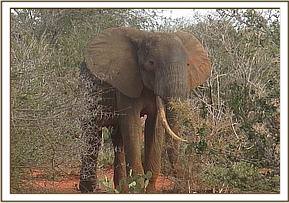
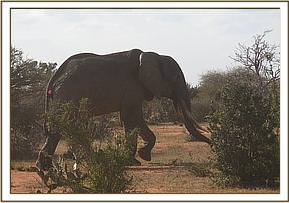
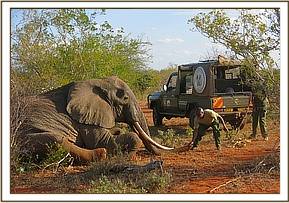

Examination and Treatment
Thorough examination was done to confirm earlier observation and any other concurrent sighting. The only injury on the left side was the abdominal one. It was probed with long forceps for any foreign body and to determine depth. No foreign body was recovered. The wound was cleaned with Hydrogen Peroxide and Iodine followed by infiltration generally with wet green clay. Meanwhile candidate was injected with systemic broad-spectrum antibiotics consisting of 15000mgs Amoxicillin into muscles, 100mgs Dexamethasone as anti-inflammatory and 100ml Vitamin B-Complex as metabolic stimulant into different muscle sites. A flip was organized by placing a strap between the front legs and the hind legs anchoring the two ends onto the vehicle which pulled the animal to the left recumbence. The arrow head was slowly retrieved using hand and forceps manipulation.
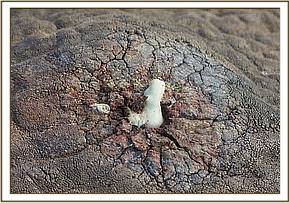
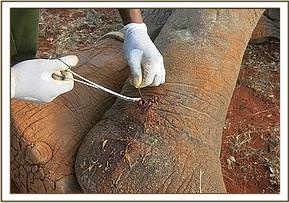
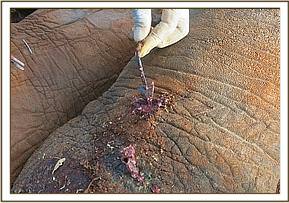

Reversal
We watched from far as it got up energetically and run away without paying any interest to what had happened.
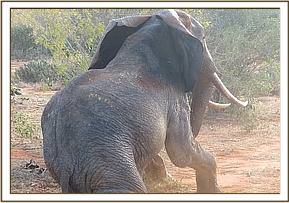

Prognosis
It is guarded unless the arrow head was not laced with poison. By sustaining two injuries to what seemed to be within one month it appears to be a poaching target and keen surveillance was recommended.
10. POPULATION CONTROL OF CATS AND BABOONS
History
It was noted that the Amboseli National Park Headquarter has been experiencing a high population of domestic cats and olive baboons of late. Fighting and aggressive males have also been observed within Amboseli Oltukai Lodge.
Cats are believed to have originated from Maasai homesteads bordering the park and eventually breeding at a high rate hence the population. The baboon troop has large males who threaten children and women within the rangers’ camp. Some have attacked women and children at compost pits when they go to dispose refuge.
The population growth needs to be controlled without necessarily impacting negatively on lives of the subjects. The Mobile Vet Unit has taken up the task of population control through spaying the female cats and vasectomy of entire males of both cats and baboons. In addition, one or two male candidates of each subject will be neutered and then monitored to observe behavior change regarding aggressiveness, dominance and weight gain. All candidates operated will be marked appropriately by ear notching to allow post-operative monitoring.
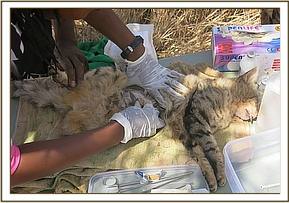
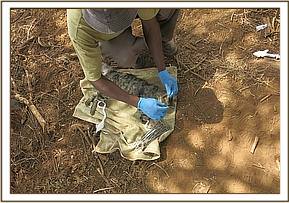
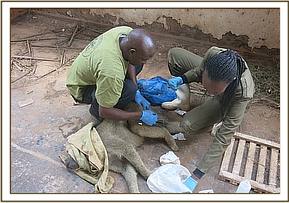

Trial ovariohysterectomy in selected female baboons will be attempted and monitor the healing process and success. A further trial of tubal ligation will also be attempted and results recorded.
